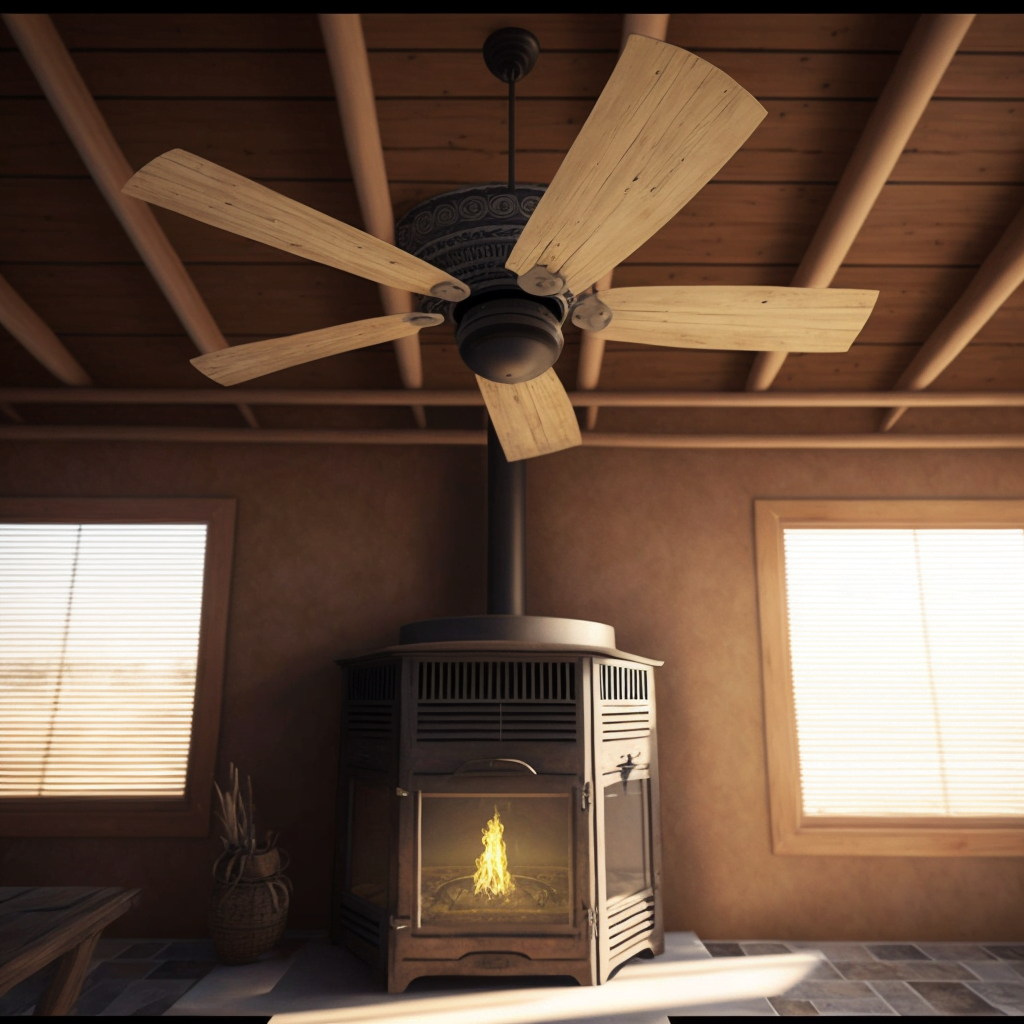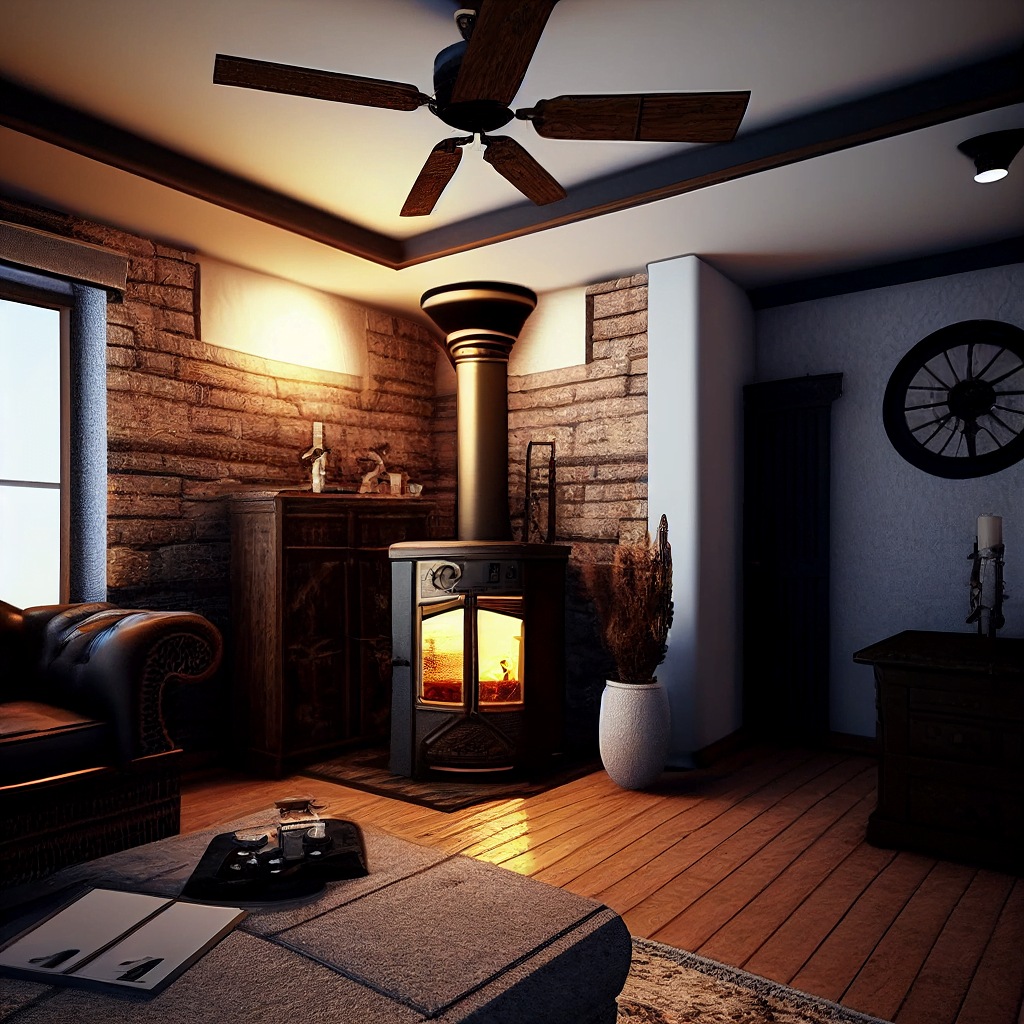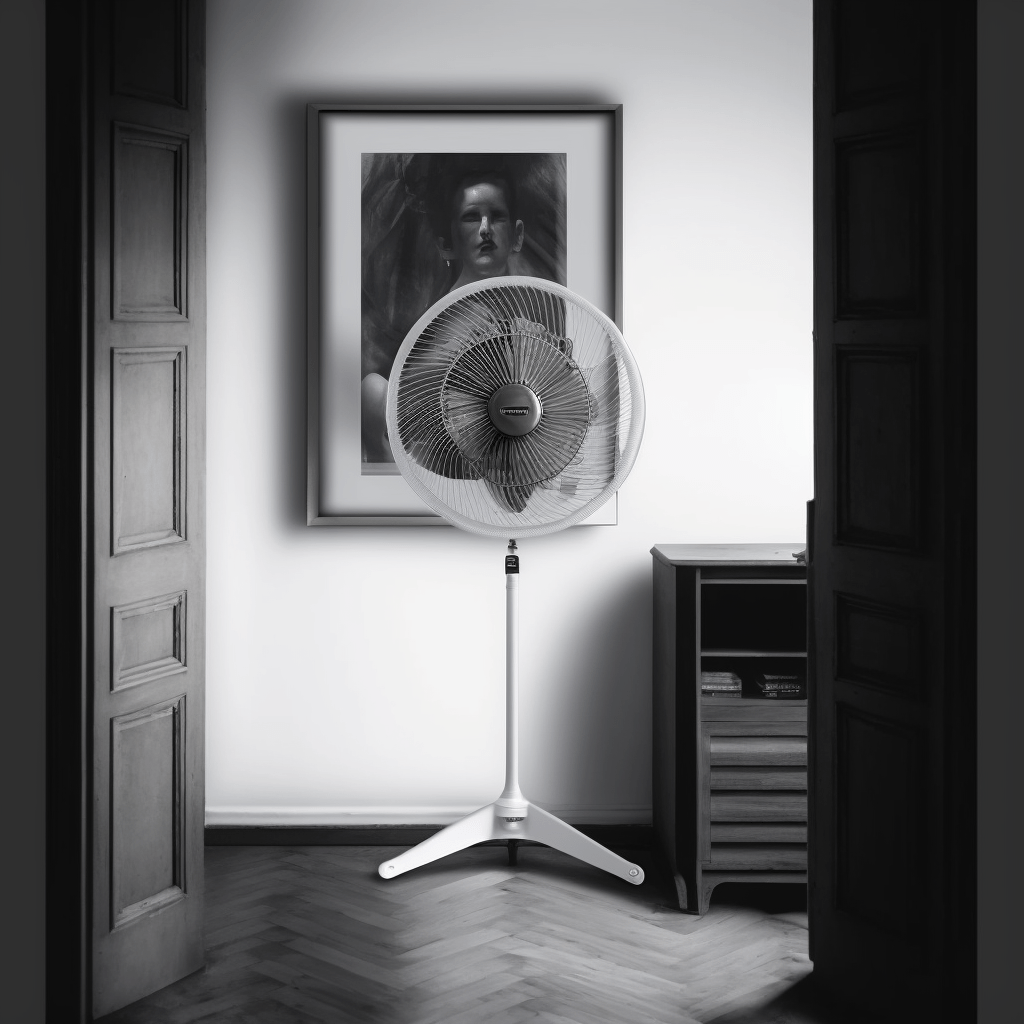A pellet heater is a great way to heat your house, but sometimes it’s hard to distribute heat from a pellet heater evenly. Below I’m going to give you some easy and practical tips to help distribute the heat from your pellet heater more evenly throughout your home. I’ll be going over using a ceiling fan in winter mode, using floor box fans to push heat away from or cold air towards your pellet heater and using inline ducting to transfer cold air to the room the pellet heater is in or transfer heat away from that room. Using any one of these you’ll be able to make the most of your pellet heater and stay warm and cozy.

Here’s the short version of how to better distribute heat from your pellet heater. Doing this will help evenly distribute heat throughout your house and at the very least you’ll get more better distributed heat out of the wood pellets you are already burning each year. Read on below if you want to know more details of each tip:
- Keep doors open
- Use a ceiling fan
- Use a floor fan
- Install inline ducting
Open Doors for Better Air Circulation
Opening doors is a simple yet effective way to improve the circulation of warm air in your home. By opening the doors in the room where your pellet heater is located and in the rooms that you want to heat, you create a pathway for warm air to travel to those areas. This helps to spread the heat more evenly and make the most of the heat put out by your pellet heater.
It’s obvious that a closed door will trap heat in a room. However, make sure doors are fully open, all the way. You want to create the least amount of resistance hot air coming from your pellet heater has and encourage it to transfer to other rooms in your house. By ensuring doors are fully open, you allow warm air to flow more freely from the pellet heater to other parts of the house. This is important if you live in a large home or multi-story home where heat might get trapped or has difficulty reaching rooms far away from the pellet heater.
Closing doors to rooms that you do not want to heat is just as important. This helps to prevent warm air from being wasted in areas where it is not needed. Maybe you’ve got a study or storage room that you rarely use. Keep the door closed to stop heat flowing into that room and being wasted. Even if you do use the room sometimes, just open it a few hours before you go in. This will ensure the room isn’t too cold that you can’t use it. By keep doors closed to unused rooms you’ll keep the rest of your house warm and burn fewer pellets as you are heating a smaller area.
Maximize Your Ceiling Fan’s Potential

If you have a ceiling fan in your home, switch it on to help move heat from your pellet heater more efficiently around your house. Most people think of ceiling fans as a way to stay cool when it’s hot. However, by changing the direction of the blades, the fan can be used to push warm air down and circulate it more evenly during the winter months. Hot air rises, so you’ll often find the ceiling of a room is the warmest because hot air gets trapped up there.
To use your ceiling fan to distribute heat from your pellet heater, you need to switch the fan to winter mode. The winter mode setting is usually located on the fan’s remote control or on the actual fan itself and is marked as “winter” or “reverse.” In winter mode, the fan will spin in the opposite direction. Hot air will be pushed down and cold air sucked up. This helps even out the temperature in a room and pushes that hot air to adjacent rooms and hallways.
It is important to run the ceiling fan on low when using it with your pellet heater. Running the fan on high can create a strong breeze which, despite being warm air, will make you feel cold. By running the fan on low, the warm air is distributed slowly and doesn’t give you such a cold sensation as running on high speed. This helps create a comfortable and cozy environment in your home.
Finally, using a ceiling fan in winter mode with your pellet heater can also help you save money by reducing how many pellets you burn. With the hot air more evenly distributed around the room, your pellet heater’s temperature sensor will switch from high to low heating mode sooner. This is because hot air that is normally trapped up near the ceiling is now spread more evenly around the room making it warmer, so your pellet heater knows the room has reached your desired temperature and then goes into low mode saving pellets.
Blow Hot Air Away with a Floor Fan
Using a floor fan is a great way to distribute heat more evenly from your pellet heater and prevent hot air from becoming trapped near the ceiling. When a pellet heater is running, hot air rises and collects near the ceiling, making lower parts of the room, like the floor, feel colder. The bigger the room or area you are heating, the more noticeable this will be. By using a floor fan to blow hot air away from the pellet heater, you help spread heat more evenly around the room.
To use a floor fan with your pellet heater, place the fan on the floor near the pellet heater and aim it towards the heater or a wall near the heater. This will help air, such as the air trapped near the ceiling, circulate around the room and towards the floor. The air flow from the fan will also encourage hot ait to move to other rooms in the house.
As I mentioned above with a ceiling fan, if you do use a floor fan run it on low speed, not high. Running a fan on high can create strong a strong breeze that will make you feel cold and possibly move warm air away from your heater and the room too quickly, not allowing it to heat up. By running them on low, you can ensure that the heat is distributed evenly and gradually, creating a comfortable and consistent temperature in your home.
Again, using a floor fan will reduce how much you spend on pellets every winter. The cost to run a fan is nothing, and increasing air flow in the room where your pellet heater is will make it warmer, causing the pellet heater to run in low more often than high. Also, you’ll find that this airflow will make other rooms in your house warmer.
Pull Cold Air Towards the Pellet Heater

Blowing cold air towards your pellet heater is another effective trick you can use to distribute heat more evenly throughout your home. To use a floor fan to blow cold air towards your pellet heater, place the fan in or near the door way to the room the pellet heater is in. Point the fan into that room, so when you switch it on it sucks cooler air from the hallways or adjoining room and blows it into the room the pellet heater is in.
Pushing cooler air into this room then forces warmer air out and helps warm air circulate around your room and house better. It is important to run the fan on low mode when using it to blow cold air towards your pellet heater. Running the fan on high can create a strong breeze that can create cold drafts and make you feel cold. By running the fan on low, you can ensure that the air is circulated evenly and gradually, creating a comfortable and consistent temperature in the room.
Which is better? Blowing cool air into the room the pellet heater is in or blowing hot air out of that room? You’ll find people who prefer one over the other method but at the end of the day I don’t think it matters. The most important point is hot air gets trapped near the pellet heater and in that room. By increasing air flow in that room you will distribute the heat more evenly around the room and your house.
Again, as with above doing this will save you money. You will be surprised at just how hot the ceiling in the room where your pellet heater can get. The floor might be 18 degrees and the ceiling could easily be 25 degrees. Using a ceiling or floor fan will even this heat out, to say 22 degrees overall and your pellet heater won’t run on high heat as long and you’ll find other rooms in your house are warmer.
The Benefits of Inline Ducting
If you’re looking for a more advanced way to distribute heat from your pellet heater, then inline ducting is an excellent option. Inline ducting works by connecting the room your pellet heater is in to other rooms in your house, using a duct that is installed in the roof space. The duct is equipped with a fan that can either draw warm air out of the room the pellet heater is in and transfer it to other rooms, or pull cold air from the other rooms and push it to the room with the pellet heater.
You can see that incline ducting is very similar to using a ceiling fan or floor fans. The difference is that all rooms can be connected and you can either blow air into or out of these rooms. This is useful if you live in a very large house, as you’ll be able to transfer air around more evenly than you can with a ceiling or floor fan. However, there are a few things you need to keep in mind if you want to install an inline duct. First, some heaters can be connected directly to inline ducts, like Piazzetta pellet heaters, whilst others can’t and ducting must just be installed in the room and not directly to the heater.
Connecting more rooms will impact how well your pellet heater can heat the rooms. The more rooms you connect the more space you are trying to heat. A small pellet heater that has a maximum heat output of say 6kw obviously won’t heat such a large number of rooms as say a 13kw pellet heater could. I would only connect rooms to the inline duct that you used a lot or you slept in, like bedrooms. The more rooms you connect, no mater how big your pellet heater is, the less efficient the duct will be in transferring heat.
Also, pellet heaters are not wood heaters. What do I mean? I mean inline ducting will work with a pellet heater but taper your expectations. Pellet heaters are space heaters and not central heaters. The inline duct will warm the other rooms but there are many things to consider. How big is your pellet heater? How big is the room it is in? How many rooms do you want to connect to the inline duct? How big are those rooms? All of this impacts how well the inline duct will be in transferring heat around your house.
What’s the Best Option?
There’s obviously a lot of ways you can help transfer heat around your house better. If you ask me what the best option is, I would pick either a ceiling fan or an inline duct. There’s nothing wrong with using floor fans but a ceiling fan is much better at moving heat trapped up near the ceiling, because it’s obviously sitting up there on the ceiling where all the heat is trapped. Even if you don’t have a ceiling fan they are cheap and easy to install, so I’d say definitely get one if you don’t already have one.
Inline ducting is also good, but as I mentioned above you need to be careful. A ceiling fan will make the room the pellet heater is in warmer and it will move air to rooms nearby better. An inline duct will move hot air to other rooms in the house better than a ceiling fan but you’ll still notice a difference in temperature between these rooms. If you wanted an inline duct, I’d install it yourself, like I did. Getting someone else to install once can cost a lot of money and I don’t think they are worth it considering how cheap ceiling fans are and effective they are.
How to Transfer Pellet Heater Heat Summary
You can help distribute heat from a pellet heater more efficiently using a few tricks. Using a ceiling fan in winter mode, a floor fan to blow hot air away from the pellet heater, a floor fan to blow cold air towards the pellet heater, inline ducting, and opening and closing doors. If you are still looking to buy a pellet heater, then don’t forget to try the tricks above to heat more of your house with your pellet heater. All of these tricks help transfer warm air generated by the pellet heater is evenly throughout your home. This will make your pellet heater more efficient and help heat just about any house no matter the size.
Resources
How to get more heat from your pellet stove
